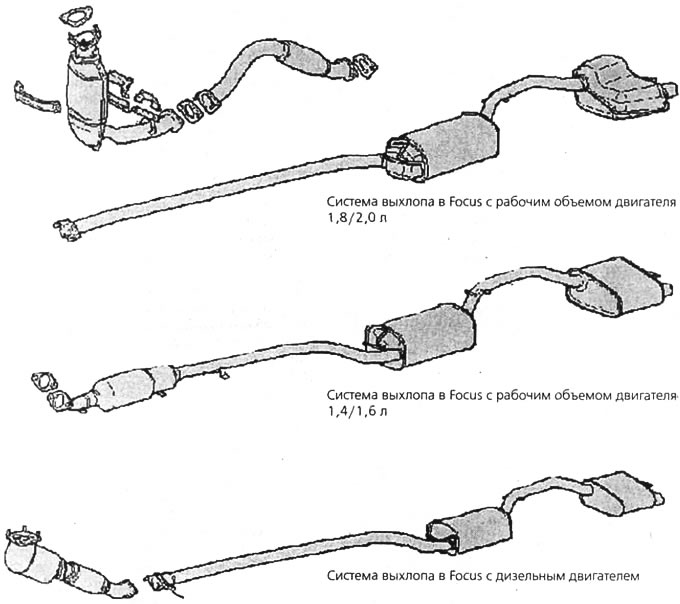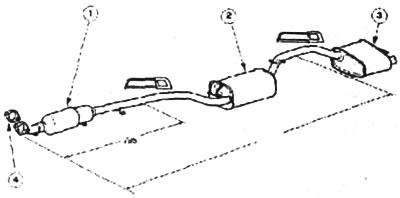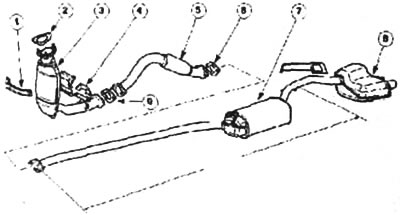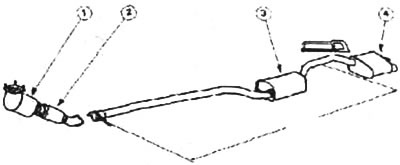
Exhaust systems were originally supposed to «only» to reduce the noise of the combustion process in the engine and to discharge exhaust gases in an orderly manner into the atmosphere - this was once the case. Already in the 80s, the exhaust had another job: since then, catalytic converters have removed up to 90% of the harmful substances contained in the exhaust gases. Focus is equipped with a single-section exhaust system. It consists of a triple acting variable catalyst (diesel engine with oxidation catalyst) and flexible intermediate piece. Then, after it, the exhaust gases go outside through a single-flow reflective and main muffler. Heat shields in the area of the catalytic converter and muffler prevent excessive heat radiation to the lower body parts.
Ford covers the need for spare parts with two- and three-section service systems. When installing the service section, you cut with a metal saw or angle grinder a one-section factory system in the appropriate place. But first check if the old muffler is strong enough to hermetically seal the spare part with a clamping collar.

Exhaust system in Focus 1.4 / 1.6 l: 1 - catalytic converter; 2 - intermediate muffler; 3 - end silencer; 4 - gasket.

Exhaust system in Focus 1.8 / 2.0 l: 1 - holder of the catalytic converter; 2 - gasket; 3 - catalytic converter; 4 - Holder; 5 - flexible pipe; 6 - gasket; 7 - intermediate muffler; 8 - end silencer; 9 - gasket.

Exhaust system in Focus with diesel engine: 1 - catalytic converter; 2 - flexible pipe; 3 - intermediate muffler; 4 - end silencer.
The exhaust system in the Focus can withstand about 70,000 km of run
Of course, the life of the exhaust system is highly dependent on the operating conditions of your car: if you drive mainly in urban areas or for short distances, then significantly more corrosive condensate, soot and aggressive acids settle inside the exhaust system. Exhaust systems that are well warmed up when driving on country roads last much longer. As a rule, the Focus exhaust system withstands a mileage of about 70,000 km.
The front of the exhaust system resists corrosion better than the rest of the system. Cause: The temperature of the exhaust gases in this part still reaches 800-1000°C, so splashes of water and condensate can evaporate very quickly.
On its way through the baffle and end silencer to the end exhaust pipe, the exhaust gases are increasingly cooled. They enter the atmosphere, depending on the method of work (diesel or petrol engine) at a temperature of about 150-300°C. Therefore, most of the condensate accumulates in the end silencer. A mixture of combustion residues and aggressive acids gradually destroys the muffler from the inside.
Since the hot exhaust system underneath the vehicle is constantly exposed to cold showers due to splashing water, large temperature fluctuations occur. When traveling long distances, they especially destroy the front of the exhaust system. This can lead despite the flexible intermediate piece (turbo diesel engine 1.8/2.0 l), to the appearance of even pipe breaks and fine hairline cracks.
Splashes of water or salt water contribute to corrosion on the outside. Rock impacts or other mechanical contact, such as hitting hard ground, are just as likely to harm the exhaust system as are harmful vibration frequencies, often caused by brittle or cracked suspension rubber.
Visitor comments